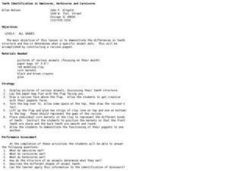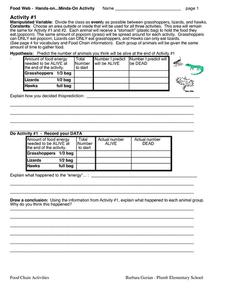Consortium for Ocean Science Exploration and Engagement (COSEE)
Arctic Smorgasbord
Though the walrus spends roughly one third of its time on land, it eats organisms that live on the bottom of the ocean. The first in a series of five, the lesson uses a variety of plant and animal cards to have scholars build an arctic...
Curated OER
Food Chain Chant
Students memorize a poem using various reading strategies to reinforce the concept of the food chain and the terminology associated with it.
Curated OER
Wildlife Animal Skulls
Students observe skulls of wild animals and determine their characteristics for survival. They evaluate the skuylls to discover the diets, and if the animals were predators or prey. They complete worksheets on mystery skulls.
Curated OER
Biodiversity
In this biodiversity learning exercise, students sort and classify animals by their observable features using a dichotomous key. Students then respond to questions about complete and incomplete metamorphosis.
Curated OER
Teeth Identification in Omnivores, Herbivores and Carnivores
Students practice identifying teeth. In this biology lesson plan, students explore the differences in teeth structure and how it determines what a specific animal eats by constructing a raccoon puppet.
Curated OER
Food Chains, Food Webs, Biomass Pyramids and Cycle
In this food chains worksheet, students complete a crossword puzzle by placing 16 terms into the puzzle that match the clues given. Students review food webs, biomass pyramids, and the water cycle.
Shelby County Schools
How Ecosystems Work
How does one organism get its energy? What is the main source of energy in an ecosystem? How does the flow of energy affect different types of ecosystems? Answer these questions with a fill-in-the-blank worksheet.
Biology Junction
Energy Flow Through an Ecosystem: Food Chains, Food Webs, and Energy Pyramids
When a minnow eats a piece of plastic, that garbage often tracks through multiple animals, causing harm to each as it passes through the food chain. Scholars learn about food chains, food webs, and energy pyramids with a presentation. It...
Curated OER
Fun With Food Chains
Students explore our ecosystem by researching animal eating habits. For this food chain lesson, students identify the links between predator and prey and the energy that passes between organisms based on what their diet consists of....
Kentucky School for the Deaf
Levels of Organization within an Ecosystem
From tiny organisms to entire biomes, young scientists examine the interdependent relationships tying all living and non-living things together with this collection of ecology resources.
Curated OER
Food Chain Activities
Transform young biologists into grasshoppers, lizards, and hawks as you teach them about food chains in an interactive life science simulation. Working collaboratively to act out three different scenarios involving...
Polar Trec
Bering Sea Fabulous Food Chain Game
In spring, the Bering Sea turns green due to phytoplankton, which live at the surface, experiencing a population explosion. Groups of scholars play a food chain game, writing down food chains as the game is played. After five to six...
Howard Hughes Medical Institute
Modeling Food Webs in Darién, Panama
It's a jungle out there! Young biologists journey to Darien, Panama to examine the intricate relationships between the organisms that inhabit the jungle. Groups begin by demonstrating an understanding of energy flow in ecosystems, then...
Purdue University
Mammals and Ecosystems
Mammals have unique interactions with their ecosystems. Using a multi-part lesson, learners research local mammals using recommended websites and use their findings to create their own paper ecosystems including appropriate mammals. They...
Curated OER
Mammals: Teeth and Diet
In this mammals' teeth and diet learning exercise, students read for information, identify kinds of teeth, and sort animals into categories. In this fill in the blank and T-Chart learning exercise, students write multiple answers for two...
Curated OER
What Animals Eat
First graders organize animals according to what they eat. They compare the teeth of plant eaters and meat eaters.
Curated OER
Food Chain
In this science instructional activity, students match the words given in the first column with the correct definition found in the second column. There are six vocabulary terms to define.
Curated OER
What Does It Eat?
Young scholars, working in research teams, investigate the eating habits of crickets. They collect and record data and compare their methods and results with other groups by making tables or graphs. They sumarize their findings with...
Curated OER
Adopt-A-Dinosaur Fact Sheet
In this science worksheet, students complete the blank fact sheet by selecting a dinosaur of their choice. They name its family, size, location, time period found, foods ate, and some amazing facts about it.
Curated OER
What Do Animals Eat?
In this animal diet worksheet, students will brainstorm what animals eat and write it down in a graphic organizer. Then students will brainstorm what people should eat and write it down.
Curated OER
Dinosaur Tag
Learners review dodging, chasing and fleeing skills while reinforcing concepts about dinosaurs. They need to review the following concepts about how dinosaurs eat and move: Herbivores eat plants, carnivores eat meat, and omnivores eat both.
Curated OER
Vocabulary: Kansas Prairies
Learners explore the ecosystem by reviewing scientific vocabulary terms. In this environmental awareness lesson, students identify the differences between abiotic and biotic factors and their relationship to the Earth. Learners define...
Curated OER
Cut and Paste Food Chain
Students study life science. In this food chain lesson, students discover the different types of animals that make up an ecosystem. They discuss as a class and then work independently on a food chain activity. This lesson includes a...
Curated OER
In the Company of Wild Butterflies
Learners discover the life cycle of a butterfly and explain the different stages. In this exploratory lesson students watch a video and create insect art and they will get an opportunity to view live specimens of butterflies.

























